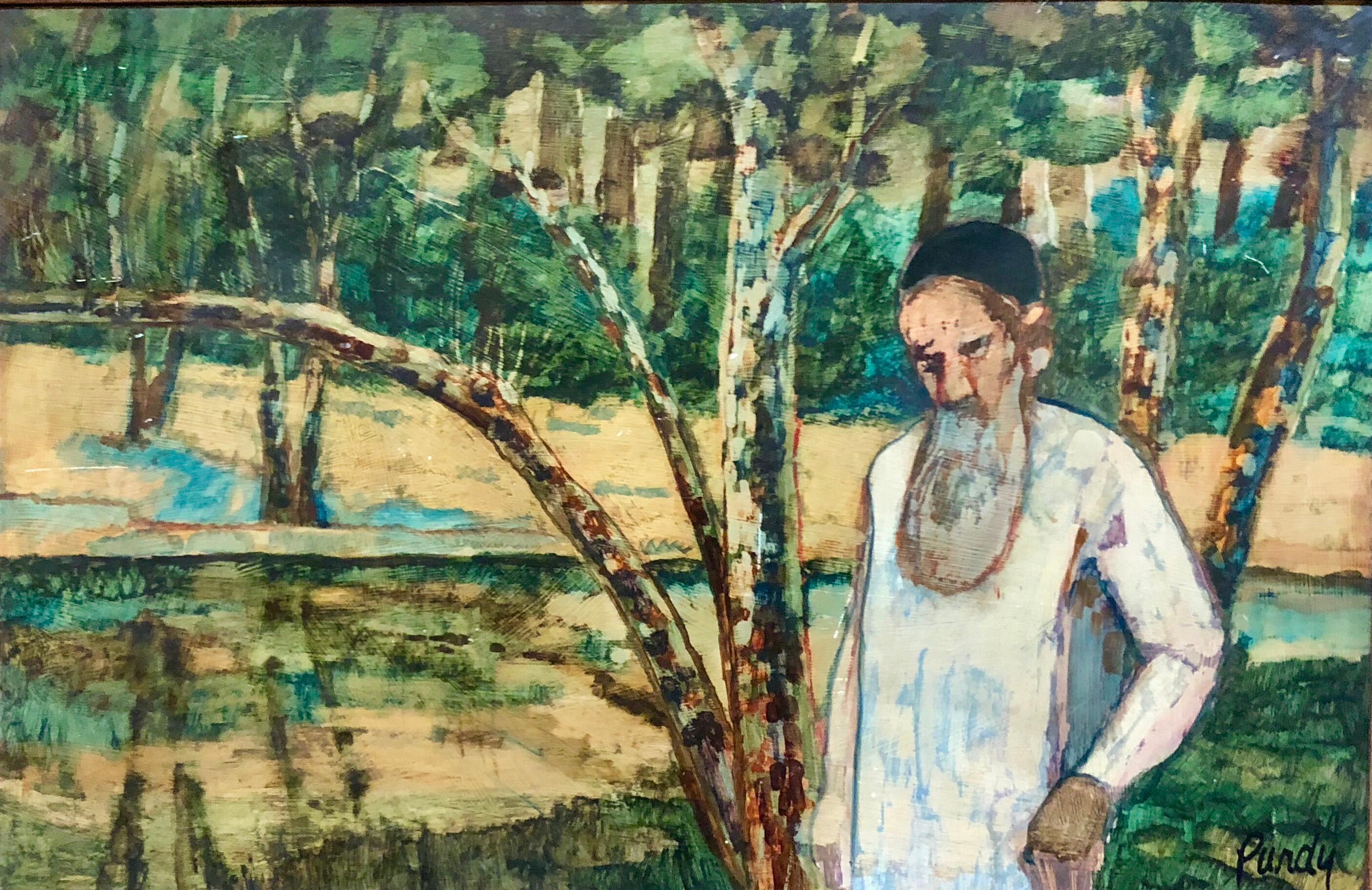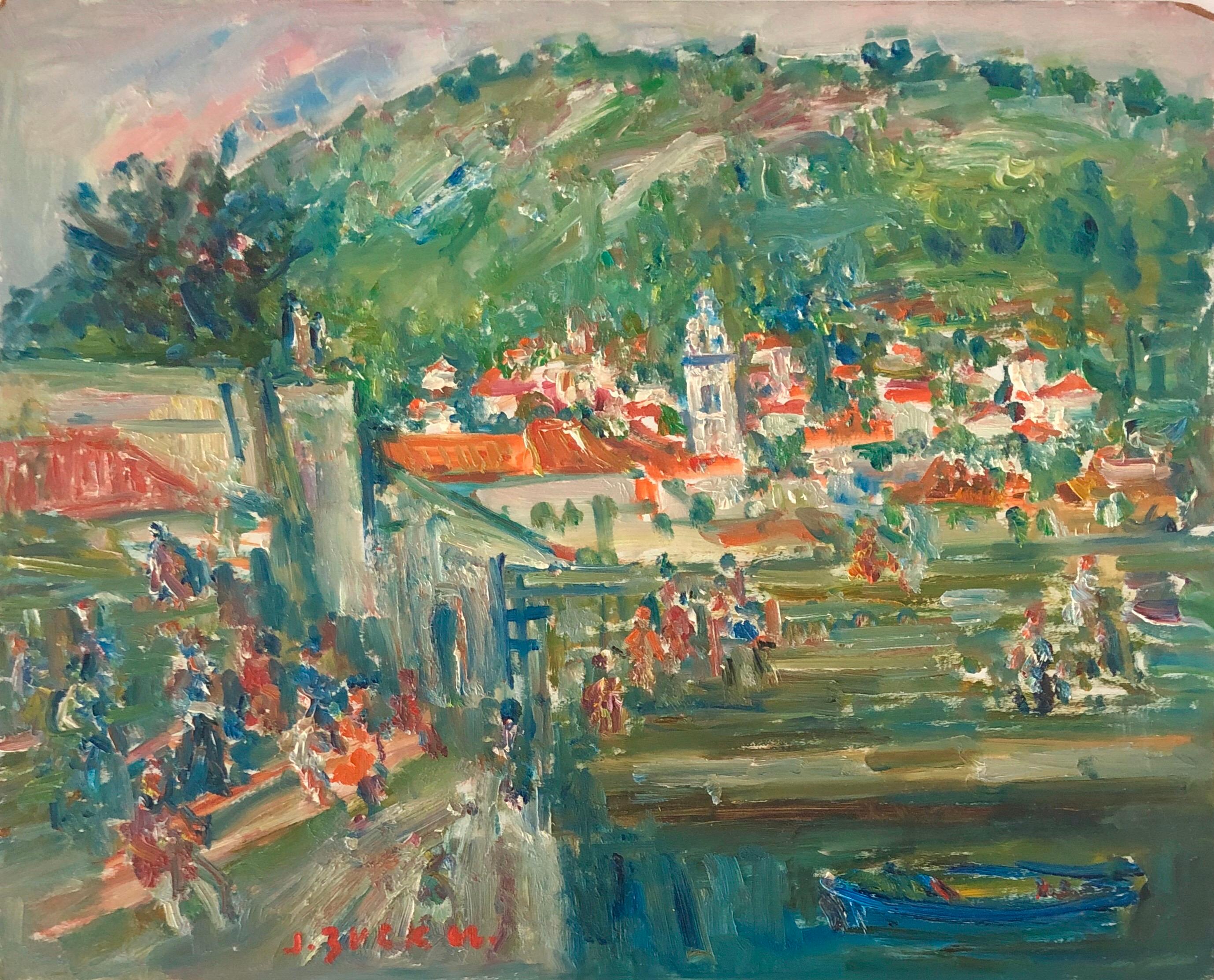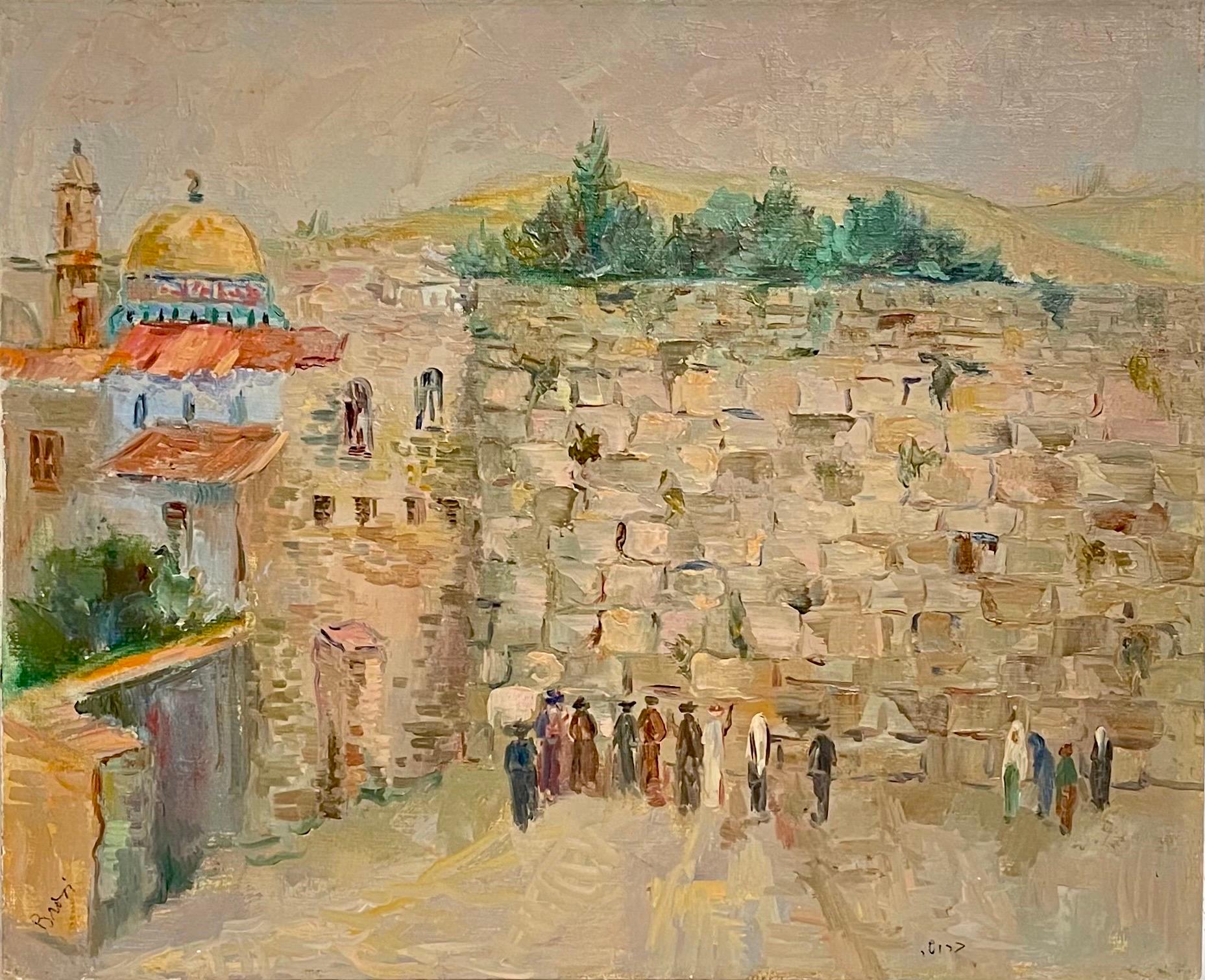Items Similar to Early 20th Century Impressionist Seascape, Harbor and Town Scene
Want more images or videos?
Request additional images or videos from the seller
1 of 8
Charles Salis KaelinEarly 20th Century Impressionist Seascape, Harbor and Town Scene
About the Item
Charles Salis Kaelin (American, 1858–1929)
Harbor and Town
Oil on canvas
25.75 in. h. x 27.75 in. w., as framed
18 in. h. x 20 in. w., canvas
Described as an artist whose "love of nature amounted to a passion," Charles Salis Kaelin was one of the earliest American exponents of Divisionism. A respected member of the art colony at Rockport, Massachusetts, Kaelin's colorful renderings of Cape Ann scenery were championed by many of his fellow artists, including Frank Duveneck, one of the first to recognize the high quality and innovative nature of his work.
Kaelin was born in Cincinnati in 1858, the son of a Swiss lithographer. Following in his father's footsteps, he entered a local lithographic firm at the age of sixteen. In the fall of 1877, he enrolled in evening classes at the McMicken School of Design (later known as the Art Academy of Cincinnati), where he was taught by Thomas Satterwhite Noble. During the summer or fall of 1878 Kaelin supplemented his studies at the McMicken by taking additional instruction from John Henry Twachtman, who had just returned to Cincinnati after sojourns in Munich and Venice. Not surprisingly, Twachtman's emphasis on landscape themes and his sketchy, Munich-inspired style appealed to Kaelin's own penchant for nature and subjective expression, much more so than Noble's preoccupation with academic portraiture and genre themes.
Kaelin traveled to New York City in 1879, enrolling in classes at the Art Students League. He continued to live there throughout the 1880s and early 1890s, working as a lithographer and painting during his spare time. Returning to Cincinnati in 1892, he joined the prestigious Strobridge Lithographic Company, as a designer of theater posters, calendars and other forms of advertising art. In the years ahead, he took many sketching trips throughout southern Ohio and Kentucky. Working exclusively in pastel, a medium in which he excelled, he portrayed the countryside in a delicate, poetic manner, reminiscent of Twachtman. His earliest critical recognition came in 1899, when the Cincinnati Art Museum organized an important solo exhibition devoted exclusively to his pastels.
At the urging of his friend and fellow artist, Frank Duveneck, Kaelin made his first trip to Gloucester, Massachusetts, in the summer of 1900. Inspired by the clear, brilliant light of the region, as well as by the rugged coastlines and pine forests that typified the area, Kaelin continued to make seasonal visits to the North Shore for well over a decade. After coming into contact with several of the American Impressionists who painted in Gloucester, such as Twachtman, Theodore Wendel, and Childe Hassam, he abandoned his earlier, tonal manner and took a greater interest in light and color. At the same time, he also began to employ a divisionist technique, associated with European Post-Impressionism, in which long, emphatic strokes of crayon were tightly woven together to create an overall tapestry of line and color. Contemporary critics spoke frequently of the "daring" and "experimental" nature of his work.
In 1916, Kaelin relinquished his lucrative career as a lithographer and settled permanently in Rockport, the smaller of the two principal towns on Cape Ann. In the years ahead, he spent his time rendering the sun-dappled harbor and the nearby woodland forests, working in both pastel and oil.
Although his desire for solitude often led to his being referred to as the "hermit painter," Kaelin's name was consistently linked with art activity in the Midwest and in the Northeast. In Cincinnati, his work was frequently displayed at the annual exhibitions of the Cincinnati Art Museum, the Society of Western Artists, and the Duveneck Society of Painters and Sculptors. He also had important one-man exhibitions in Cincinnati (1913, 1920), Saint Louis (1909), and Buffalo (1920). In 1915, he was awarded a silver medal at the Panama-Pacific Exposition for his pastels. Following his move to Rockport, Kaelin's work was exhibited at the Gallery-on-the-Moors in Gloucester, the Boston Art Club, and the Pennsylvania Academy of the Fine Arts in Philadelphia. He was also a founding member of the Rockport Art Association (1921). In 1930, a year after his death, Kaelin's numerous friends and admirers organized an important memorial exhibition of his work for Traxel's Galleries in Cincinnati.
Examples of Charles Kaelin's work can be found in many public and private collections, including the Metropolitan Museum of Art, New York; the Butler Institute of American Art, Youngstown, Ohio; the Cincinnati Art Museum; the Cape Ann Art Association, Gloucester; the Rockport Art Association; the Achenbach Foundation for Graphic Arts, Fine Arts Museums of San Francisco; and ITT Corporation, New York.
- Creator:Charles Salis Kaelin (1858-1929, American)
- Dimensions:Height: 25.75 in (65.41 cm)Width: 27.75 in (70.49 cm)
- Medium:
- Movement & Style:
- Period:
- Condition:
- Gallery Location:Beachwood, OH
- Reference Number:1stDibs: LU176829749262
About the Seller
No Reviews Yet
Vetted Seller
These experienced sellers undergo a comprehensive evaluation by our team of in-house experts.
Established in 1975
1stDibs seller since 2022
9 sales on 1stDibs
Typical response time: 1 to 2 days
- ShippingRetrieving quote...Ships From: Beachwood, OH
- Return PolicyA return for this item may be initiated within 14 days of delivery.
More From This SellerView All
- 20th Century Industrial Cityscape Oil painting, Cleveland School ArtistBy Joseph O'SickeyLocated in Beachwood, OHWork sold to benefit the CLEVELAND INSTITUTE OF ART Joseph B. O’Sickey (American, 1918–2013) Industrial Cityscape Oil on paper Signed lower left 13.75 x 16.5 inches Joseph O'Sicke...Category
Late 20th Century Post-Impressionist Landscape Paintings
MaterialsOil
- Boat at the End of a Jetty, Seascape Coastal New England SceneBy Jonas LieLocated in Beachwood, OHJonas Lie (American, 1880-1940) Boat at the End of a Jetty OIl on canvas board Signed lower right 12.75 x 10.5 inches 18.75 x 16.75 inches, framed Jonas Lie was a prolific painter, ...Category
Early 20th Century American Impressionist Figurative Paintings
MaterialsOil
- 20th Century Bucks County Colorful Landscape Painting, Italian artistBy Louis BosaLocated in Beachwood, OHLouis Bosa (American, 1905–1981) Bucks County, 1934 Oil on canvas Signed and dated lower right 17.5 x 21.5 inches 25.5 x 29 inches, framed Born in Codroipo, a small village only a f...Category
1930s Expressionist Figurative Paintings
MaterialsOil
- Early 20th Century Harbor Scene Seascape/Landscape PaintingBy Abel WarshawskyLocated in Beachwood, OHAbel Warshawsky, American (1883-1962) Harbor Scene Oil on Canvas Signed lower right 13 x 16.25 canvas 17 x 20 inches framed Early 20th Century Harbor Scene Seascape/Landscape Pain...Category
Early 20th Century American Impressionist Figurative Paintings
MaterialsOil
- Spring, Majorca (Puig Major), 20th Century Spanish Mountainous LandscapeBy Abel WarshawskyLocated in Beachwood, OHAbel Warshawsky (American 1883-1962) Spring, Majorca (Puig Major) Oil on wood panel Unsigned, title inscribed verso 24 x 20 inches 29 x 25.25 inches, framed Impressionist painter A....Category
20th Century American Impressionist Landscape Paintings
MaterialsOil
- Spring Fantasy, Mid-20th Century American Impressionist LandscapeBy Abel WarshawskyLocated in Beachwood, OHAbel Warshawsky (American 1883-1962) Spring Fantasy, 1948 Oil on artist's board Signed lower right and verso 16 x 13 inches 20 x 17 inches, framed Impressionist painter A.G. Warshaw...Category
1940s American Impressionist Landscape Paintings
MaterialsOil
You May Also Like
- Judaica Meditative Rabbi at Prayer in Nature, Large Landscape Oil PaintingBy Donald Roy PurdyLocated in Surfside, FLGenre: Modern Subject: Jewish Elder , Judaic Prayer Surface: Board Country: United States signed lower left Donald Roy Purdy is an American painter whose work evolved through a rang...Category
20th Century Fauvist Figurative Paintings
MaterialsOil, Board
- Large French Oil Painting Paris, Seine River w Bridge, Landscape, Lucien DelarueBy Lucien DelarueLocated in Surfside, FLLucien Delarue (1925-2011) Paris Seine River Scene. "Seine at Paris" Provenance: Newman Gallery, Phila. Label verso. Hand signed on Canvas. Dimensions: H: 25 inches: W: 31.5 inches: Frame: 35 X 41 inches Artist Lucien Delarue was born in Paris in 1925, and he is known for his spectacular cityscape painting. Post Impressionist painter He studied at the studios of Grande Chaumiere, Paris and was a pupil of Maitre Yves Brayer. He is best know as a French Impressionist. He loved to paint the romantic streets of Paris with its stunning architecture and beauty. Also included in his repertoire is colorful French floral still life paintings, South of France country cottages, harbor views, and river scenes. At a very early age Delarue began taking part in exhibitions. Quickly he was talking medals for his works including first prize and the Vermeil-Medaille at the Salon Violet. Other gold medals include the Salon of Vincennes, and the Salon of Clichy (1973). In 1974 he won the silver medal at the Salon des Artistes Francais, and a bronze medal at the "Arts-Sciences-Lettres" exhibition in Paris. He also exhibited works at the Museum of Ile de France in the chateau of Sceaux. He held exhibitions in New York and in San Francisco in the United States. He was a member of the Salon des Artistes Francais and of the French Watercolor Society.Lucien Delarue excelled in recreating the cottages, harbor views, and expressionist architecture of Paris in his artwork. His watercolor paintings include color-rich representations of France's many scenic rivers. Delarue would eventually become a member of the French Watercolor Society and the Salon des Artistes Francais. He showed with Henk Bos...Category
Mid-20th Century Post-Impressionist Landscape Paintings
MaterialsCanvas, Oil
- French Riviera Harbor Scene Oil Painting Ecole D'Paris, WPA, Bezalel ArtistBy Jacques ZuckerLocated in Surfside, FLGenre: Post Impressionist Subject: Landscape Medium: Oil Surface: board Country: France Dimensions: 13" x 16" Jacques Zucker was born in 1900 in Radom, Poland. He was a notably famous Jewish American artist mostly known for his expressionist figure paintings. In his young years he traveled to Palestine to study fine arts at the Bezalel Art School in Jerusalem. In 1917 he joined the British Royal Fuesiliers under the leadership of General Allenby to liberate Palestine from the Turks. After the first World War he settled in Paris, where he continued his studies at Académie Julian and Academie Colarossi. He then emigrated to the United States in 1922 and continued his art studies at the National Academy of Design. He supported himself by designing jewelry. In 1925 he returned to Paris and studied at the Academie de la Grande Chaumier et Colarossi. During the Depression he worked for the WPA. From 1928 he took part in the Paris Salons: Autumn and the Tuileries. His works are expressionistic variations in the type of the Ecole de Paris. As a protégé of both Chaim Soutine and Renoir, hints of their style can be observed in much of his own work. Zucker’s style, that may have been influenced from the art of artists such as Marc Chagall, took pride in being an “internationalist”, standing the art of painting in its highest expression is universal no matter where the canvas was created. People who respond to quality in art will understand the beauty and meaning, in their own land or in a foreign land, this was his main idea behind his artworks that was exhibited in numerous solo show in leading galleries and museums in New York, Paris, Tel Aviv, and other art centers. Claude Roger-Marx of Figaro Litteraire, dean of French art critics, write a comprehensive study of Zucker’s illustrated with 135 color and black and white plates. He traveled widely, including Italy, Spain, Portugal, Mexico and Israel. From then on Zucker lived alternately in New York and Paris, maintaining homes in both places, and spent considerable time painting in Mexico, Portugal, Greece, and Israel. Zucker's post-impressionist works including town and landscapes, still-lives, and portraits, are part of an array of permanent installments in numerous museums and private collections in Tel Aviv, including the Joseph Hirschorn collection in Washington, D. C., the Museum of Modern Art in Paris, and the Bezalel Art Museum in Jerusalem. In 1947 he settled in Arcueil near Paris. Zucker died in 1981 in New York. The School of Paris, Ecole de Paris, was not a single art movement or institution, but refers to the importance of Paris as a center of Western art in the early decades of the 20th century. Between 1900 and 1940 the city drew artists from all over the world and became a centre for artistic activity. School of Paris was used to describe this loose community, particularly of non-French artists, centered in the cafes, salons and shared workspaces and galleries of Montparnasse. Before World War I, a group of expatriates in Paris created art in the styles of Post-Impressionism, Cubism and Fauvism. The group included artists like Pablo Picasso, Marc Chagall, Amedeo Modigliani and Piet Mondrian. Associated French artists included Pierre Bonnard, Henri Matisse, Jean Metzinger and Albert Gleizes. The term "School of Paris" was used in 1925 by André Warnod to refer to the many foreign-born artists who had migrated to Paris. The term soon gained currency, often as a derogatory label by critics who saw the foreign artists—many of whom were Jewish—as a threat to the purity of French art. Art critic Louis Vauxcelles, noted for coining the terms "Fauvism" and "Cubism", Waldemar George, himself a French Jew, in 1931 lamented that the School of Paris name "allows any artist to pretend he is French. it refers to French tradition but instead annihilates it. The artists working in Paris between World War I and World War II experimented with various styles including Cubism, Orphism, Surrealism and Dada. Foreign and French artists working in Paris included Jean Arp, Joan Miro, Constantin Brancusi, Raoul Dufy, Tsuguharu Foujita, artists from Belarus like Michel Kikoine, Pinchus Kremegne, and Jacques Lipchitz, the Polish artist Marek Szwarc and others such as Russian-born prince Alexis Arapoff. A significant subset, the Jewish artists, came to be known as the Jewish School of Paris or the School of Montparnasse. The core members were almost all Jews, and the resentment expressed toward them by French critics in the 1930s was unquestionably fueled by anti-Semitism. Jewish members of the group included Emmanuel Mané-Katz, Chaim Soutine, Adolphe Féder, Chagall, Moïse Kisling, Maxa Nordau and Shimshon Holzman...Category
Mid-20th Century Post-Impressionist Landscape Paintings
MaterialsBoard, Oil
- French Fauvist Post Impressionist Beach Scene, Umbrellas Jean Sardi Oil PaintingLocated in Surfside, FLJean Sardi, French (b. 1947). "Beach Scene" Signed Lower Right Framed 16 x 19. image 11 x 14 Jean Sardi is a French Post War & Contemporary painter who wa...Category
20th Century Post-Impressionist Figurative Paintings
MaterialsOil, Board
- Russian Israeli Oil Painting Western Wall Jerusalem Judaica Post ImpressionistLocated in Surfside, FLBroshi (Brodetz) Yoseph (Lehi alias Uriel) 1913- 1980 Russian Israeli artist. An oil painting depicting Jewish people praying at the Western Wall or Wa...Category
Mid-20th Century Post-Impressionist Landscape Paintings
MaterialsBoard, Oil
- Large Modernist Fauvist Oil Painting Constantin Kluge French Countryside BloomsBy Constantine KlugeLocated in Surfside, FLConstantine Kluge (French 1912-2003) Les Pommiers en Fleurs Oil on canvas of apple trees in bloom Hand signed lower right. Provenance: purchased from Wally Findlay Galleries. (bear...Category
1960s Post-Impressionist Figurative Paintings
MaterialsCanvas, Oil
Recently Viewed
View AllMore Ways To Browse
Charles H Wells
Munich Vintage Poster
Death In Venice Painting
Art Posters Western
Metropolitan Art Museum Poster
Metropolitan Museum Of Art Poster
The Metropolitan Museum Of Art Poster
John Moor
Vintage Long Cape
Solitude Man
Metropolitan Exhibition Poster
Art Exposition Poster
Theater Sketches
Philadelphia Poster
Lithographic Poster Museum
Forest Poster
Swiss Graphic Design Poster
Metropolitan Museum Of Art Posters Vintage





